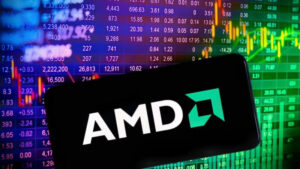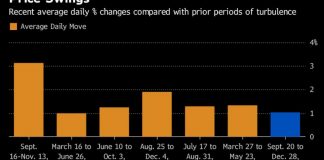JUNE 6, 2024

The artificial intelligence (AI) industry is buzzing with innovation and investment opportunities, especially with big names like AMD (AMD), Nvidia (NVDA), and Intel (INTC) showcasing their next-gen AI chips at Computex 2024. AMD unveiled a slew of new AI processors, including the MI325X accelerator, which will hit the market in Q4 2024. This chip packs a punch, with 288GB of HBM3E memory, making AMD a formidable rival to Nvidia.
AMD’s announcements at Computex also featured its longer-term AI chip development roadmap. The company has teamed up with industry heavyweights like Microsoft (MSFT) for its cloud platform Azure, Meta Platforms (META), Dell Technologies (DELL), Hewlett Packard Enterprise (HPE), and Lenovo (LNVGF), which are expected to boost the adoption of its Instinct MI300X accelerators.
Meanwhile, analysts are bullish on AMD, with the consensus forecast calling for double-digit upside in this top-rated chip giant.
With the AI race intensifying, and all eyes on the $3 trillion elephant in the room, it’s worth asking – is AMD a compelling investment opportunity for long-term AI upside at current levels? Let’s delve deeper into AMD’s AI chip strategy and assess its potential for long-term growth.
AMD Stock Still Looks Reasonable Amid AI Gains
Advanced Micro Devices (AMD) is a global tech company that designs and makes microprocessors, graphics processors, and other semiconductor products. Known for its innovative approach, AMD has diversified its portfolio to serve markets like personal computers, data centers, and gaming.
AMD has been on a wild ride lately, up 40.9% over the past 52 weeks, and nearly 13% higher YTD. Despite edging out the broader S&P 500 Index ($SPX) on both counts, AMD is down about 30% from its early March highs, which means it’s possible to buy shares on the dip.
The company’s market cap has ballooned to a whopping $258.59 billion, making it one of the most valuable semiconductor companies out there.
Financially, AMD had a solid first quarter in 2024, with revenue hitting $5.5 billion, a 2% increase from the previous quarter. The company reported a gross margin of 47%, up from 44% in Q1 2023, and net income of $123 million, a big turnaround from its $139 million loss in the same period last year. This translated to diluted earnings per share (EPS) of $0.07, compared to a loss per share of $0.09 in Q1 2023. The data center segment was a standout, with record revenue of $2.3 billion, up 80% year-over-year, driven by strong sales of AMD Instinct GPUs and 4th Gen AMD EPYC CPUs.
Despite the impressive stock performance, AMD’s valuation remains reasonable. The company’s price-to-sales ratio is 10.12x, and its price-to-earnings-to-growth (PEG) ratio is 1.08. These metrics suggest that AMD is attractively priced, even compared to its hypergrowth rival Nvidia, which trades at a higher multiple of 23.86x sales, with a PEG ratio of 1.14.
Powering the AI Revolution: AMD’s Multi-Pronged Growth Strategy
AMD is making big moves with a multi-faceted growth strategy that includes exciting product launches and strategic advancements. At Computex 2024, AMD rolled out its next-gen Zen 5 Ryzen processors, which are a big step up in performance and efficiency. The Ryzen 9000 series, with up to 16 cores and a 5.7 GHz boost frequency, promises a 16% IPC uplift over its predecessor, making it a strong contender in both gaming and productivity.
At the same time, AMD has expanded its Instinct GPU roadmap, introducing the MI325X accelerator, set to launch in Q4 2024, and the MI350 series expected in 2025. These accelerators, built on the new CDNA 4 architecture, are designed to deliver up to a 35x increase in AI inference performance, positioning AMD as a leader in data center AI innovation.
Additionally, AMD’s EPYC 4004 Series processors are aimed at small and medium businesses, offering high performance and efficiency at a lower cost. These processors extend the Zen 4 architecture into entry-level systems, providing robust solutions for growing enterprises.
These strategic moves enhance AMD’s product lineup and strengthen its market position. By addressing diverse market needs – from high-end gaming and data centers to small business servers – AMD is well-positioned to capitalize on the AI revolution.
Wall Street’s Verdict: AMD’s AI Prospects Shine Bright
Wall Street analysts are pretty upbeat about AMD’s future, especially its potential in the AI market.
For the second quarter of 2024, they estimate AMD’s revenue to be around $5.7 billion, with a non-GAAP gross margin of about 53%. The consensus earnings per share (EPS) forecast for the current quarter is $0.47, up from $0.40 in the year-ago period. For the full year 2024, analysts project revenue to hit $25.83 billion, with an average EPS forecast of $2.62. Looking ahead to 2025, revenue is expected to grow significantly to $32.56 billion, with an average EPS of $4.38.
The positive vibes are reflected in the analyst ratings. Out of 34 analysts, 28 have rated AMD as a “strong buy,” one as a “moderate buy,” and five as a “hold.” The mean price target for AMD is set at $193.11, representing 16.2% upside from current levels.
Melius Research is the most bullish, predicting the stock could reach $265, while Bernstein offers a much more conservative target of $140.
Several big financial institutions have revised their price targets for AMD following its recent announcements at Computex 2024. Bank of America raised its 12-month price target from $185 to $195, while maintaining a “buy” rating. CFRA also kept its optimistic outlook with a price target of $200.
Why AMD Deserves a Spot in Your Portfolio
With a solid product lineup, impressive financial performance, and strong backing from Wall Street, the company is well-positioned for long-term growth. Its more attractive valuation compared to competitors like Nvidia also makes it a compelling buy. If you’re looking to tap into AI upside at a relatively reasonable price, AMD’s innovative approach and strategic moves make it a stock worth considering for your portfolio.
Courtesy/Source: BarChart










































































































